Organizational Behavior Report: Morrisons - Team, Culture, Motivation
VerifiedAdded on 2021/01/02
|10
|2766
|116
Report
AI Summary
This report provides an analysis of organizational behavior within Morrisons, a UK supermarket chain. It examines the influence of culture, power, and politics on individual and team behavior, exploring how these factors impact performance. The report delves into content and process theories of motivation, specifically McClelland's achievement motivation theory and goal theory, evaluating their application within Morrisons. It also identifies the factors that contribute to effective teams, contrasting them with ineffective team dynamics, and references Tuckman's stages of group development. Finally, the report applies organizational behavior concepts, such as path-goal and situational leadership theories, to a business situation characterized by high work pressure during the festive season, demonstrating how Morrisons can leverage these theories to improve employee motivation, satisfaction, and overall performance.
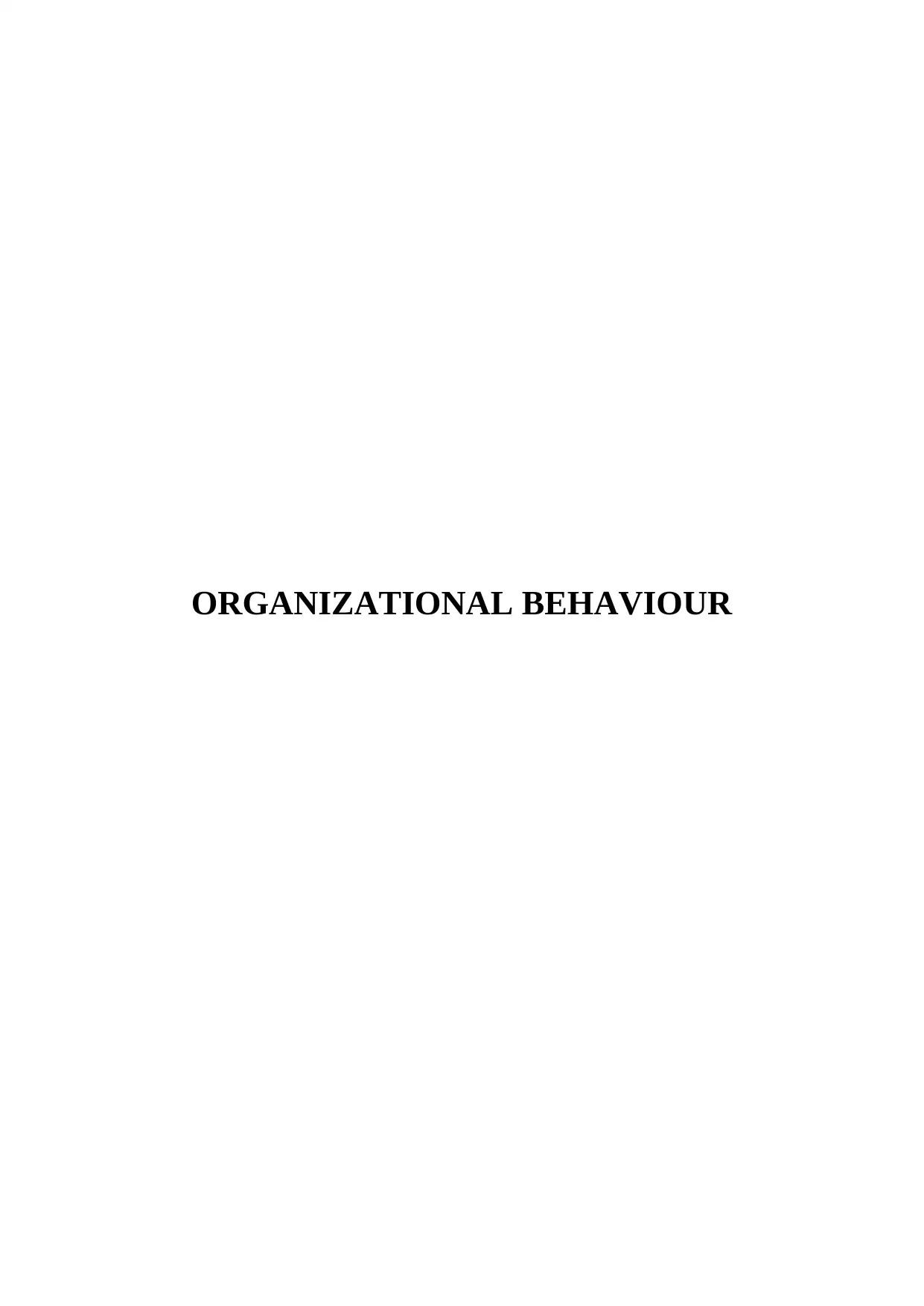
ORGANIZATIONAL BEHAVIOUR
Paraphrase This Document
Need a fresh take? Get an instant paraphrase of this document with our AI Paraphraser
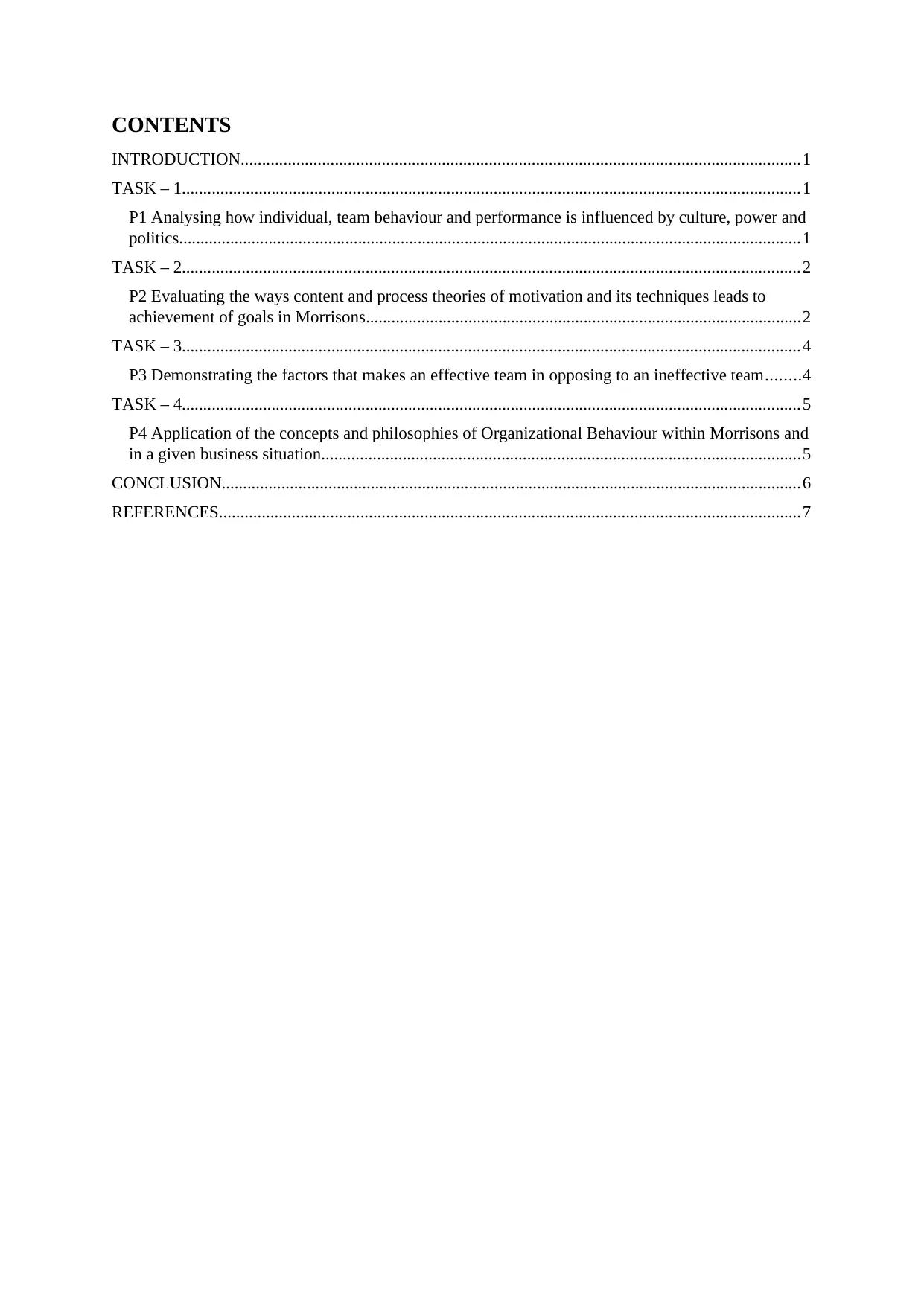
CONTENTS
INTRODUCTION...................................................................................................................................1
TASK – 1.................................................................................................................................................1
P1 Analysing how individual, team behaviour and performance is influenced by culture, power and
politics..................................................................................................................................................1
TASK – 2.................................................................................................................................................2
P2 Evaluating the ways content and process theories of motivation and its techniques leads to
achievement of goals in Morrisons......................................................................................................2
TASK – 3.................................................................................................................................................4
P3 Demonstrating the factors that makes an effective team in opposing to an ineffective team........4
TASK – 4.................................................................................................................................................5
P4 Application of the concepts and philosophies of Organizational Behaviour within Morrisons and
in a given business situation................................................................................................................5
CONCLUSION........................................................................................................................................6
REFERENCES........................................................................................................................................7
INTRODUCTION...................................................................................................................................1
TASK – 1.................................................................................................................................................1
P1 Analysing how individual, team behaviour and performance is influenced by culture, power and
politics..................................................................................................................................................1
TASK – 2.................................................................................................................................................2
P2 Evaluating the ways content and process theories of motivation and its techniques leads to
achievement of goals in Morrisons......................................................................................................2
TASK – 3.................................................................................................................................................4
P3 Demonstrating the factors that makes an effective team in opposing to an ineffective team........4
TASK – 4.................................................................................................................................................5
P4 Application of the concepts and philosophies of Organizational Behaviour within Morrisons and
in a given business situation................................................................................................................5
CONCLUSION........................................................................................................................................6
REFERENCES........................................................................................................................................7
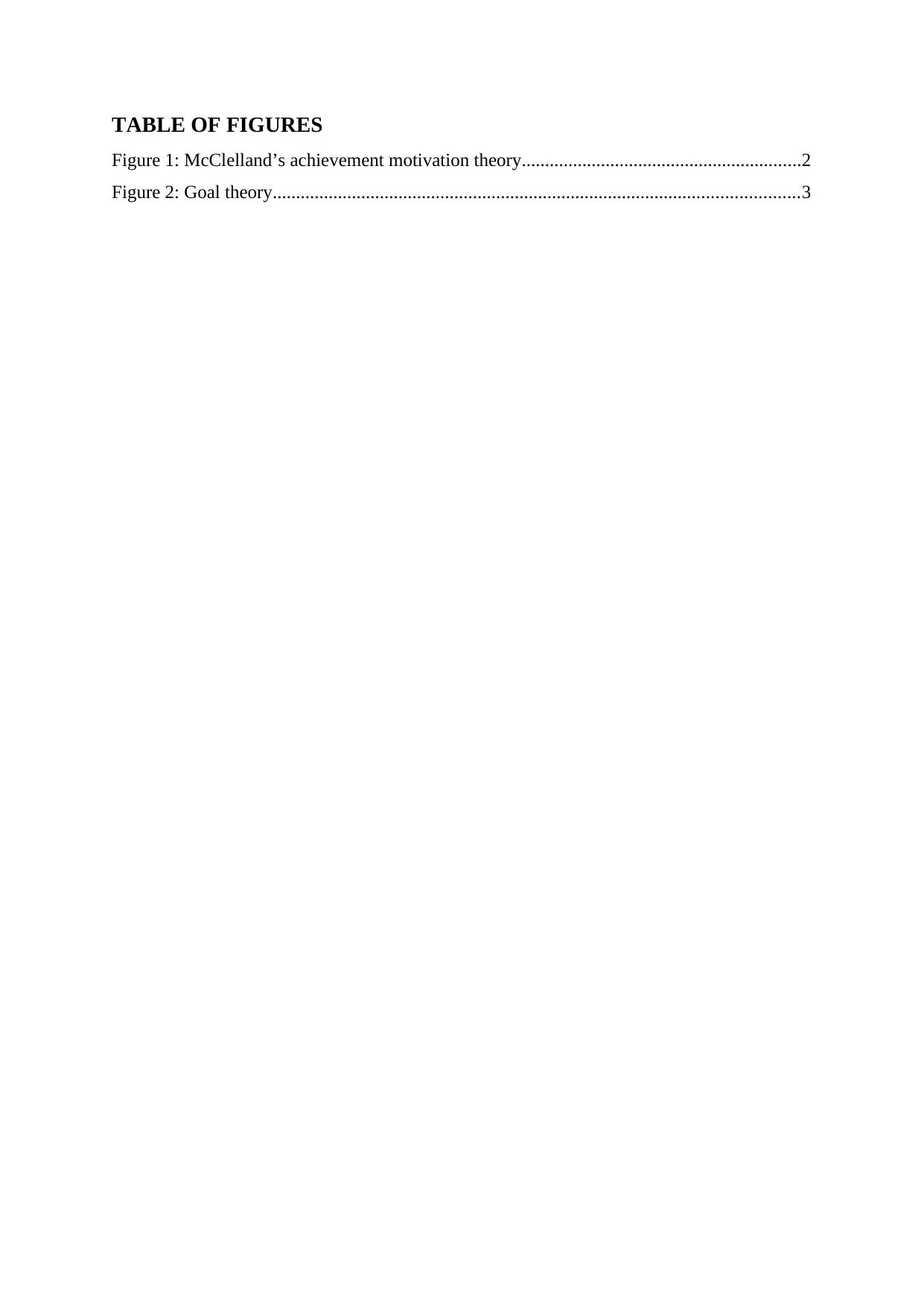
TABLE OF FIGURES
Figure 1: McClelland’s achievement motivation theory............................................................2
Figure 2: Goal theory.................................................................................................................3
Figure 1: McClelland’s achievement motivation theory............................................................2
Figure 2: Goal theory.................................................................................................................3
⊘ This is a preview!⊘
Do you want full access?
Subscribe today to unlock all pages.

Trusted by 1+ million students worldwide
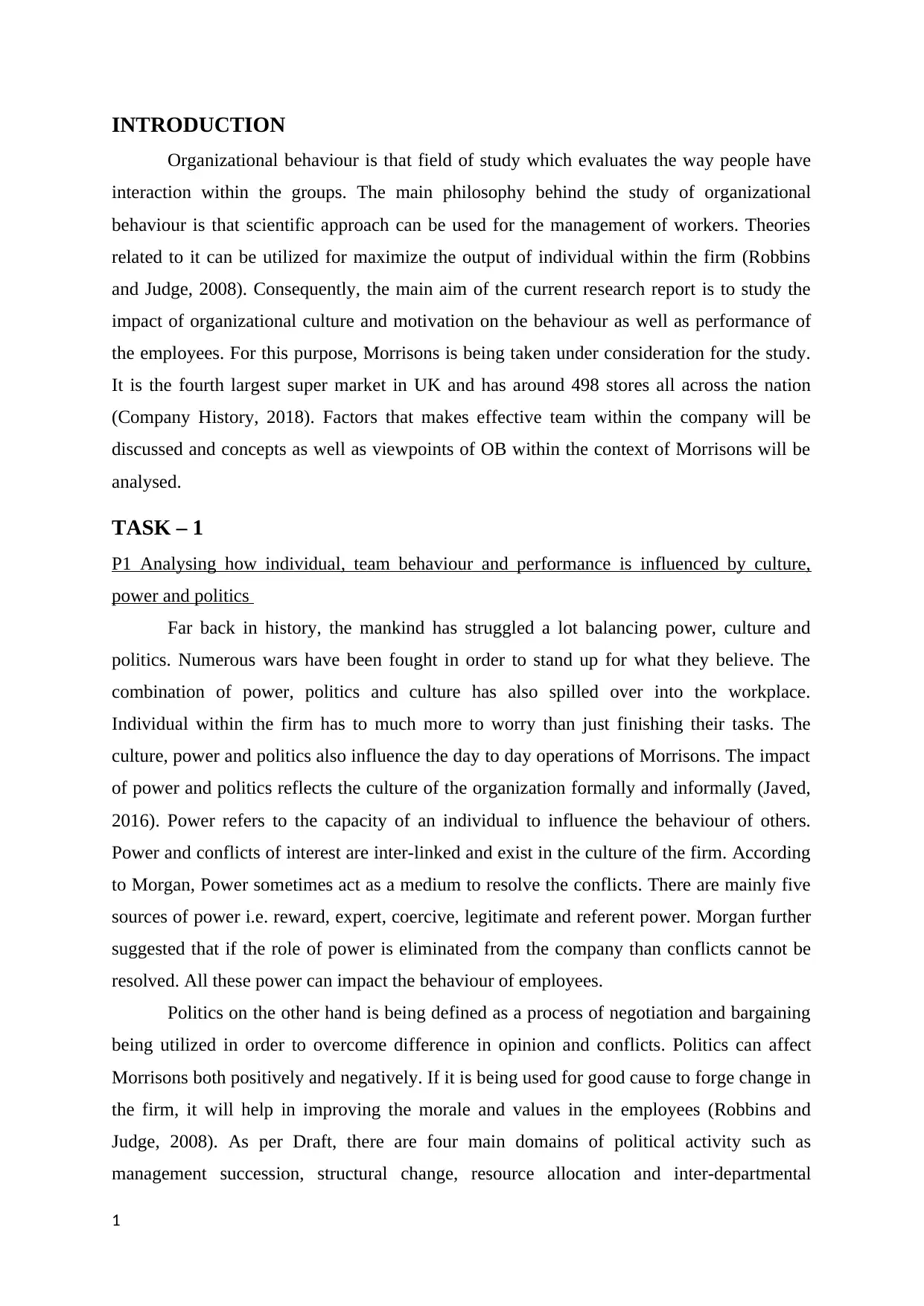
INTRODUCTION
Organizational behaviour is that field of study which evaluates the way people have
interaction within the groups. The main philosophy behind the study of organizational
behaviour is that scientific approach can be used for the management of workers. Theories
related to it can be utilized for maximize the output of individual within the firm (Robbins
and Judge, 2008). Consequently, the main aim of the current research report is to study the
impact of organizational culture and motivation on the behaviour as well as performance of
the employees. For this purpose, Morrisons is being taken under consideration for the study.
It is the fourth largest super market in UK and has around 498 stores all across the nation
(Company History, 2018). Factors that makes effective team within the company will be
discussed and concepts as well as viewpoints of OB within the context of Morrisons will be
analysed.
TASK – 1
P1 Analysing how individual, team behaviour and performance is influenced by culture,
power and politics
Far back in history, the mankind has struggled a lot balancing power, culture and
politics. Numerous wars have been fought in order to stand up for what they believe. The
combination of power, politics and culture has also spilled over into the workplace.
Individual within the firm has to much more to worry than just finishing their tasks. The
culture, power and politics also influence the day to day operations of Morrisons. The impact
of power and politics reflects the culture of the organization formally and informally (Javed,
2016). Power refers to the capacity of an individual to influence the behaviour of others.
Power and conflicts of interest are inter-linked and exist in the culture of the firm. According
to Morgan, Power sometimes act as a medium to resolve the conflicts. There are mainly five
sources of power i.e. reward, expert, coercive, legitimate and referent power. Morgan further
suggested that if the role of power is eliminated from the company than conflicts cannot be
resolved. All these power can impact the behaviour of employees.
Politics on the other hand is being defined as a process of negotiation and bargaining
being utilized in order to overcome difference in opinion and conflicts. Politics can affect
Morrisons both positively and negatively. If it is being used for good cause to forge change in
the firm, it will help in improving the morale and values in the employees (Robbins and
Judge, 2008). As per Draft, there are four main domains of political activity such as
management succession, structural change, resource allocation and inter-departmental
1
Organizational behaviour is that field of study which evaluates the way people have
interaction within the groups. The main philosophy behind the study of organizational
behaviour is that scientific approach can be used for the management of workers. Theories
related to it can be utilized for maximize the output of individual within the firm (Robbins
and Judge, 2008). Consequently, the main aim of the current research report is to study the
impact of organizational culture and motivation on the behaviour as well as performance of
the employees. For this purpose, Morrisons is being taken under consideration for the study.
It is the fourth largest super market in UK and has around 498 stores all across the nation
(Company History, 2018). Factors that makes effective team within the company will be
discussed and concepts as well as viewpoints of OB within the context of Morrisons will be
analysed.
TASK – 1
P1 Analysing how individual, team behaviour and performance is influenced by culture,
power and politics
Far back in history, the mankind has struggled a lot balancing power, culture and
politics. Numerous wars have been fought in order to stand up for what they believe. The
combination of power, politics and culture has also spilled over into the workplace.
Individual within the firm has to much more to worry than just finishing their tasks. The
culture, power and politics also influence the day to day operations of Morrisons. The impact
of power and politics reflects the culture of the organization formally and informally (Javed,
2016). Power refers to the capacity of an individual to influence the behaviour of others.
Power and conflicts of interest are inter-linked and exist in the culture of the firm. According
to Morgan, Power sometimes act as a medium to resolve the conflicts. There are mainly five
sources of power i.e. reward, expert, coercive, legitimate and referent power. Morgan further
suggested that if the role of power is eliminated from the company than conflicts cannot be
resolved. All these power can impact the behaviour of employees.
Politics on the other hand is being defined as a process of negotiation and bargaining
being utilized in order to overcome difference in opinion and conflicts. Politics can affect
Morrisons both positively and negatively. If it is being used for good cause to forge change in
the firm, it will help in improving the morale and values in the employees (Robbins and
Judge, 2008). As per Draft, there are four main domains of political activity such as
management succession, structural change, resource allocation and inter-departmental
1
Paraphrase This Document
Need a fresh take? Get an instant paraphrase of this document with our AI Paraphraser
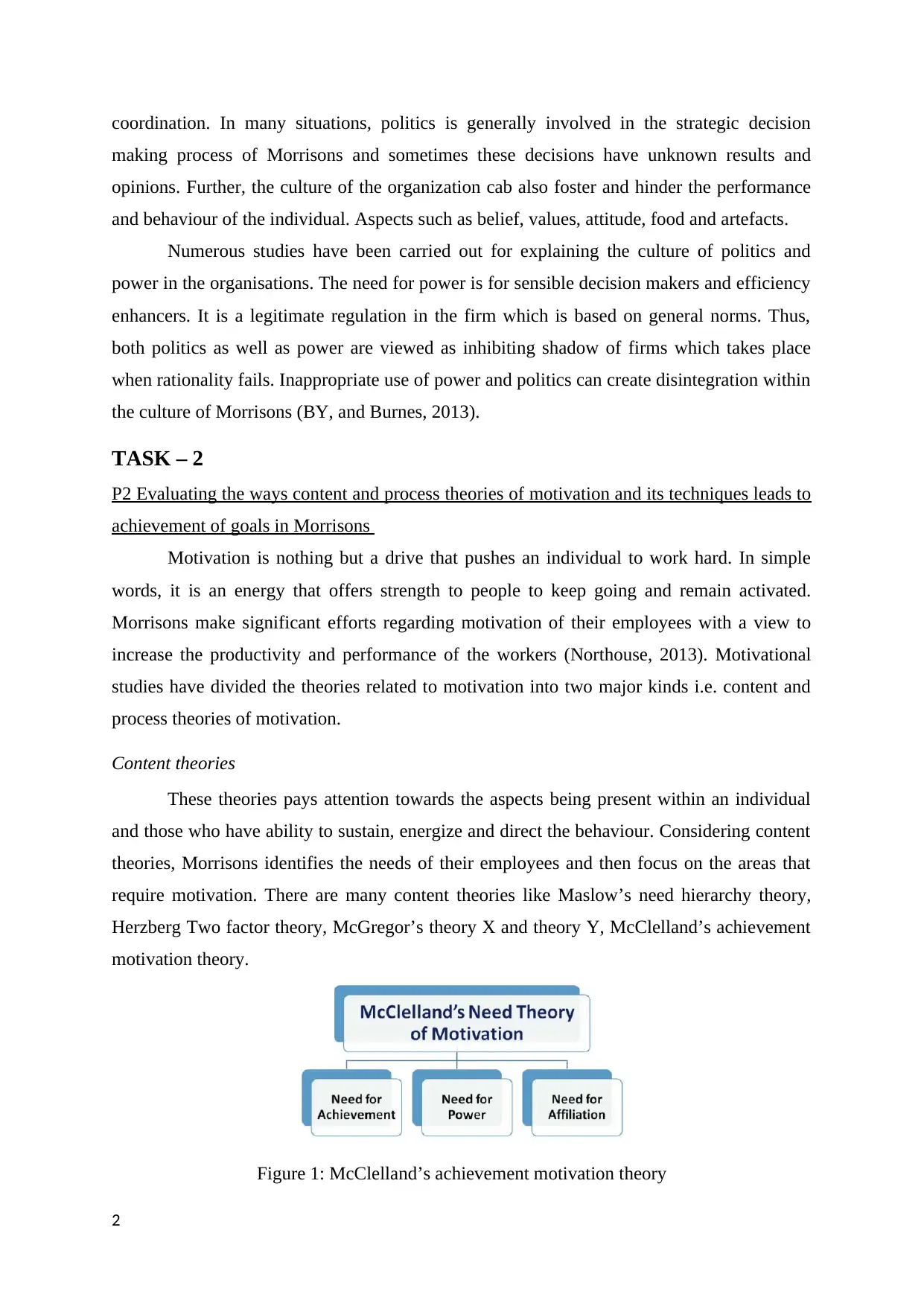
coordination. In many situations, politics is generally involved in the strategic decision
making process of Morrisons and sometimes these decisions have unknown results and
opinions. Further, the culture of the organization cab also foster and hinder the performance
and behaviour of the individual. Aspects such as belief, values, attitude, food and artefacts.
Numerous studies have been carried out for explaining the culture of politics and
power in the organisations. The need for power is for sensible decision makers and efficiency
enhancers. It is a legitimate regulation in the firm which is based on general norms. Thus,
both politics as well as power are viewed as inhibiting shadow of firms which takes place
when rationality fails. Inappropriate use of power and politics can create disintegration within
the culture of Morrisons (BY, and Burnes, 2013).
TASK – 2
P2 Evaluating the ways content and process theories of motivation and its techniques leads to
achievement of goals in Morrisons
Motivation is nothing but a drive that pushes an individual to work hard. In simple
words, it is an energy that offers strength to people to keep going and remain activated.
Morrisons make significant efforts regarding motivation of their employees with a view to
increase the productivity and performance of the workers (Northouse, 2013). Motivational
studies have divided the theories related to motivation into two major kinds i.e. content and
process theories of motivation.
Content theories
These theories pays attention towards the aspects being present within an individual
and those who have ability to sustain, energize and direct the behaviour. Considering content
theories, Morrisons identifies the needs of their employees and then focus on the areas that
require motivation. There are many content theories like Maslow’s need hierarchy theory,
Herzberg Two factor theory, McGregor’s theory X and theory Y, McClelland’s achievement
motivation theory.
Figure 1: McClelland’s achievement motivation theory
2
making process of Morrisons and sometimes these decisions have unknown results and
opinions. Further, the culture of the organization cab also foster and hinder the performance
and behaviour of the individual. Aspects such as belief, values, attitude, food and artefacts.
Numerous studies have been carried out for explaining the culture of politics and
power in the organisations. The need for power is for sensible decision makers and efficiency
enhancers. It is a legitimate regulation in the firm which is based on general norms. Thus,
both politics as well as power are viewed as inhibiting shadow of firms which takes place
when rationality fails. Inappropriate use of power and politics can create disintegration within
the culture of Morrisons (BY, and Burnes, 2013).
TASK – 2
P2 Evaluating the ways content and process theories of motivation and its techniques leads to
achievement of goals in Morrisons
Motivation is nothing but a drive that pushes an individual to work hard. In simple
words, it is an energy that offers strength to people to keep going and remain activated.
Morrisons make significant efforts regarding motivation of their employees with a view to
increase the productivity and performance of the workers (Northouse, 2013). Motivational
studies have divided the theories related to motivation into two major kinds i.e. content and
process theories of motivation.
Content theories
These theories pays attention towards the aspects being present within an individual
and those who have ability to sustain, energize and direct the behaviour. Considering content
theories, Morrisons identifies the needs of their employees and then focus on the areas that
require motivation. There are many content theories like Maslow’s need hierarchy theory,
Herzberg Two factor theory, McGregor’s theory X and theory Y, McClelland’s achievement
motivation theory.
Figure 1: McClelland’s achievement motivation theory
2
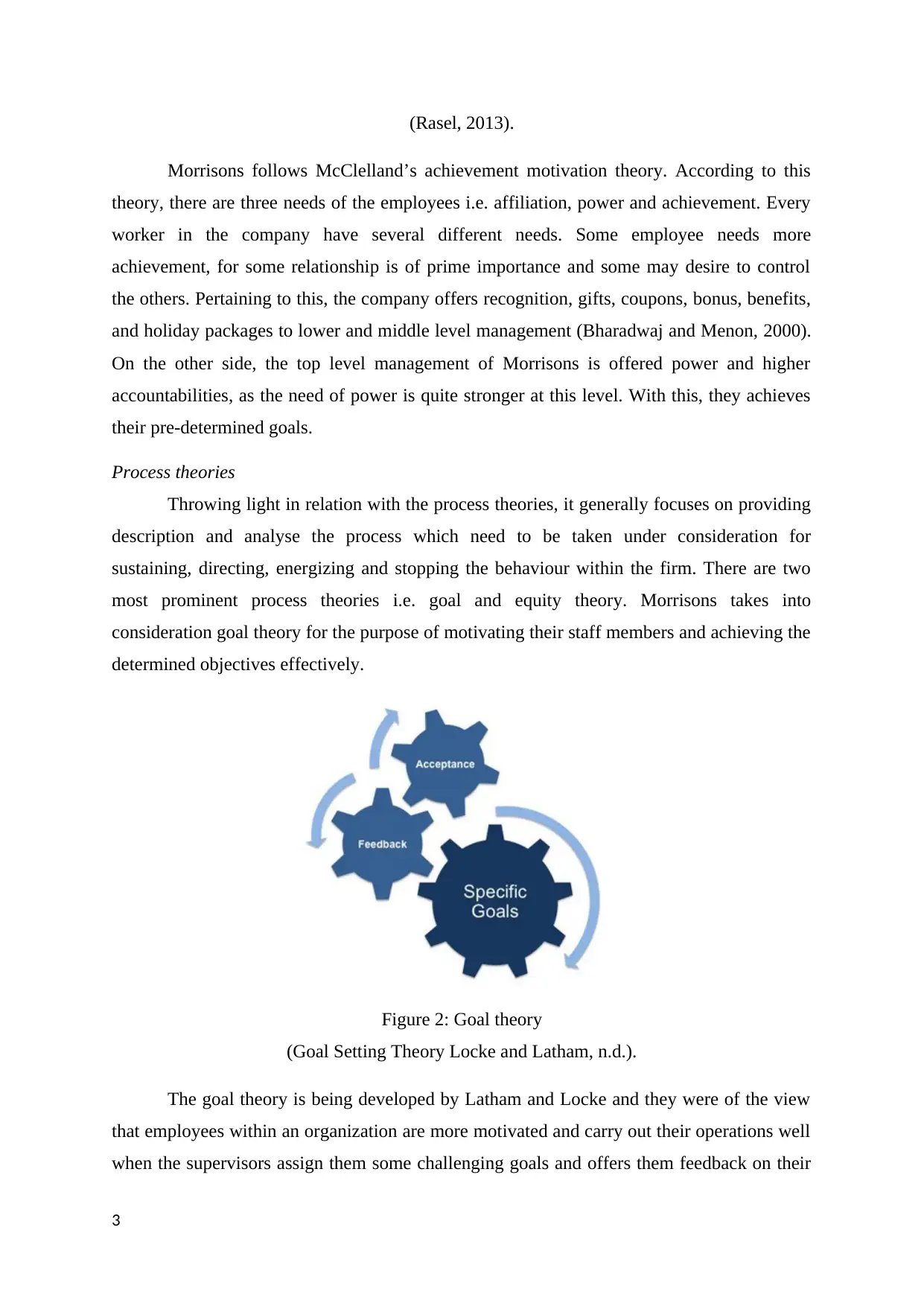
(Rasel, 2013).
Morrisons follows McClelland’s achievement motivation theory. According to this
theory, there are three needs of the employees i.e. affiliation, power and achievement. Every
worker in the company have several different needs. Some employee needs more
achievement, for some relationship is of prime importance and some may desire to control
the others. Pertaining to this, the company offers recognition, gifts, coupons, bonus, benefits,
and holiday packages to lower and middle level management (Bharadwaj and Menon, 2000).
On the other side, the top level management of Morrisons is offered power and higher
accountabilities, as the need of power is quite stronger at this level. With this, they achieves
their pre-determined goals.
Process theories
Throwing light in relation with the process theories, it generally focuses on providing
description and analyse the process which need to be taken under consideration for
sustaining, directing, energizing and stopping the behaviour within the firm. There are two
most prominent process theories i.e. goal and equity theory. Morrisons takes into
consideration goal theory for the purpose of motivating their staff members and achieving the
determined objectives effectively.
Figure 2: Goal theory
(Goal Setting Theory Locke and Latham, n.d.).
The goal theory is being developed by Latham and Locke and they were of the view
that employees within an organization are more motivated and carry out their operations well
when the supervisors assign them some challenging goals and offers them feedback on their
3
Morrisons follows McClelland’s achievement motivation theory. According to this
theory, there are three needs of the employees i.e. affiliation, power and achievement. Every
worker in the company have several different needs. Some employee needs more
achievement, for some relationship is of prime importance and some may desire to control
the others. Pertaining to this, the company offers recognition, gifts, coupons, bonus, benefits,
and holiday packages to lower and middle level management (Bharadwaj and Menon, 2000).
On the other side, the top level management of Morrisons is offered power and higher
accountabilities, as the need of power is quite stronger at this level. With this, they achieves
their pre-determined goals.
Process theories
Throwing light in relation with the process theories, it generally focuses on providing
description and analyse the process which need to be taken under consideration for
sustaining, directing, energizing and stopping the behaviour within the firm. There are two
most prominent process theories i.e. goal and equity theory. Morrisons takes into
consideration goal theory for the purpose of motivating their staff members and achieving the
determined objectives effectively.
Figure 2: Goal theory
(Goal Setting Theory Locke and Latham, n.d.).
The goal theory is being developed by Latham and Locke and they were of the view
that employees within an organization are more motivated and carry out their operations well
when the supervisors assign them some challenging goals and offers them feedback on their
3
⊘ This is a preview!⊘
Do you want full access?
Subscribe today to unlock all pages.

Trusted by 1+ million students worldwide
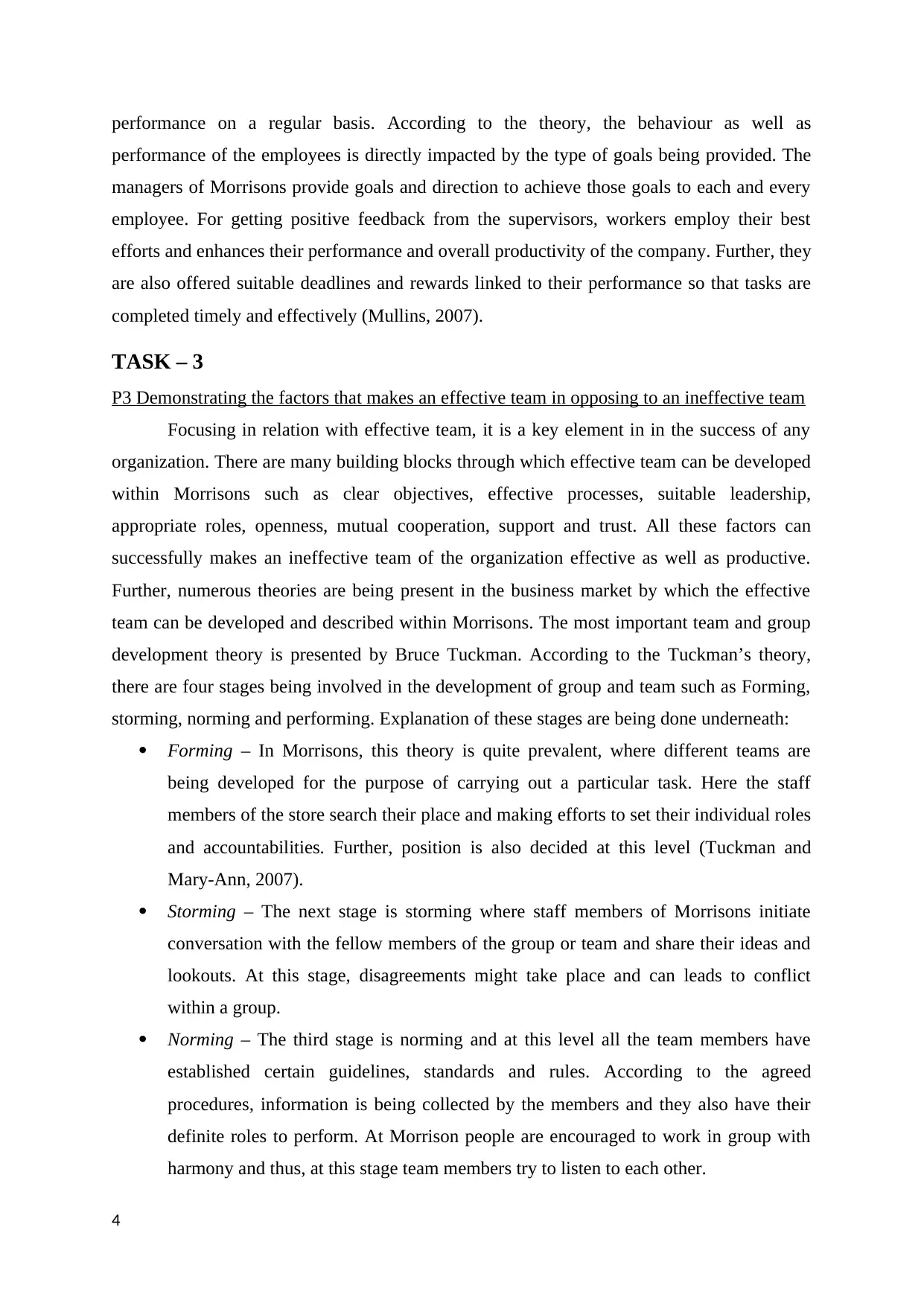
performance on a regular basis. According to the theory, the behaviour as well as
performance of the employees is directly impacted by the type of goals being provided. The
managers of Morrisons provide goals and direction to achieve those goals to each and every
employee. For getting positive feedback from the supervisors, workers employ their best
efforts and enhances their performance and overall productivity of the company. Further, they
are also offered suitable deadlines and rewards linked to their performance so that tasks are
completed timely and effectively (Mullins, 2007).
TASK – 3
P3 Demonstrating the factors that makes an effective team in opposing to an ineffective team
Focusing in relation with effective team, it is a key element in in the success of any
organization. There are many building blocks through which effective team can be developed
within Morrisons such as clear objectives, effective processes, suitable leadership,
appropriate roles, openness, mutual cooperation, support and trust. All these factors can
successfully makes an ineffective team of the organization effective as well as productive.
Further, numerous theories are being present in the business market by which the effective
team can be developed and described within Morrisons. The most important team and group
development theory is presented by Bruce Tuckman. According to the Tuckman’s theory,
there are four stages being involved in the development of group and team such as Forming,
storming, norming and performing. Explanation of these stages are being done underneath:
Forming – In Morrisons, this theory is quite prevalent, where different teams are
being developed for the purpose of carrying out a particular task. Here the staff
members of the store search their place and making efforts to set their individual roles
and accountabilities. Further, position is also decided at this level (Tuckman and
Mary-Ann, 2007).
Storming – The next stage is storming where staff members of Morrisons initiate
conversation with the fellow members of the group or team and share their ideas and
lookouts. At this stage, disagreements might take place and can leads to conflict
within a group.
Norming – The third stage is norming and at this level all the team members have
established certain guidelines, standards and rules. According to the agreed
procedures, information is being collected by the members and they also have their
definite roles to perform. At Morrison people are encouraged to work in group with
harmony and thus, at this stage team members try to listen to each other.
4
performance of the employees is directly impacted by the type of goals being provided. The
managers of Morrisons provide goals and direction to achieve those goals to each and every
employee. For getting positive feedback from the supervisors, workers employ their best
efforts and enhances their performance and overall productivity of the company. Further, they
are also offered suitable deadlines and rewards linked to their performance so that tasks are
completed timely and effectively (Mullins, 2007).
TASK – 3
P3 Demonstrating the factors that makes an effective team in opposing to an ineffective team
Focusing in relation with effective team, it is a key element in in the success of any
organization. There are many building blocks through which effective team can be developed
within Morrisons such as clear objectives, effective processes, suitable leadership,
appropriate roles, openness, mutual cooperation, support and trust. All these factors can
successfully makes an ineffective team of the organization effective as well as productive.
Further, numerous theories are being present in the business market by which the effective
team can be developed and described within Morrisons. The most important team and group
development theory is presented by Bruce Tuckman. According to the Tuckman’s theory,
there are four stages being involved in the development of group and team such as Forming,
storming, norming and performing. Explanation of these stages are being done underneath:
Forming – In Morrisons, this theory is quite prevalent, where different teams are
being developed for the purpose of carrying out a particular task. Here the staff
members of the store search their place and making efforts to set their individual roles
and accountabilities. Further, position is also decided at this level (Tuckman and
Mary-Ann, 2007).
Storming – The next stage is storming where staff members of Morrisons initiate
conversation with the fellow members of the group or team and share their ideas and
lookouts. At this stage, disagreements might take place and can leads to conflict
within a group.
Norming – The third stage is norming and at this level all the team members have
established certain guidelines, standards and rules. According to the agreed
procedures, information is being collected by the members and they also have their
definite roles to perform. At Morrison people are encouraged to work in group with
harmony and thus, at this stage team members try to listen to each other.
4
Paraphrase This Document
Need a fresh take? Get an instant paraphrase of this document with our AI Paraphraser
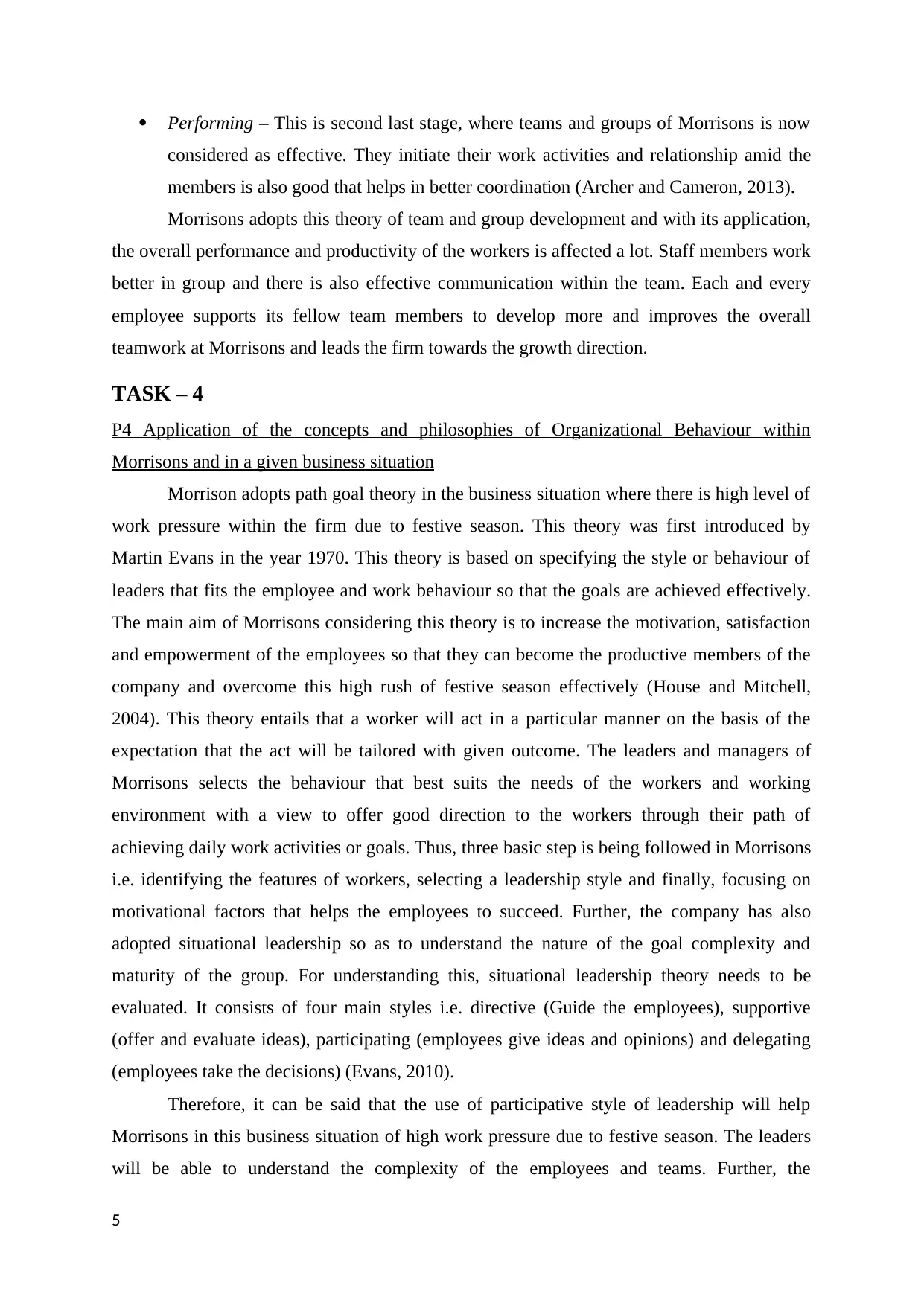
Performing – This is second last stage, where teams and groups of Morrisons is now
considered as effective. They initiate their work activities and relationship amid the
members is also good that helps in better coordination (Archer and Cameron, 2013).
Morrisons adopts this theory of team and group development and with its application,
the overall performance and productivity of the workers is affected a lot. Staff members work
better in group and there is also effective communication within the team. Each and every
employee supports its fellow team members to develop more and improves the overall
teamwork at Morrisons and leads the firm towards the growth direction.
TASK – 4
P4 Application of the concepts and philosophies of Organizational Behaviour within
Morrisons and in a given business situation
Morrison adopts path goal theory in the business situation where there is high level of
work pressure within the firm due to festive season. This theory was first introduced by
Martin Evans in the year 1970. This theory is based on specifying the style or behaviour of
leaders that fits the employee and work behaviour so that the goals are achieved effectively.
The main aim of Morrisons considering this theory is to increase the motivation, satisfaction
and empowerment of the employees so that they can become the productive members of the
company and overcome this high rush of festive season effectively (House and Mitchell,
2004). This theory entails that a worker will act in a particular manner on the basis of the
expectation that the act will be tailored with given outcome. The leaders and managers of
Morrisons selects the behaviour that best suits the needs of the workers and working
environment with a view to offer good direction to the workers through their path of
achieving daily work activities or goals. Thus, three basic step is being followed in Morrisons
i.e. identifying the features of workers, selecting a leadership style and finally, focusing on
motivational factors that helps the employees to succeed. Further, the company has also
adopted situational leadership so as to understand the nature of the goal complexity and
maturity of the group. For understanding this, situational leadership theory needs to be
evaluated. It consists of four main styles i.e. directive (Guide the employees), supportive
(offer and evaluate ideas), participating (employees give ideas and opinions) and delegating
(employees take the decisions) (Evans, 2010).
Therefore, it can be said that the use of participative style of leadership will help
Morrisons in this business situation of high work pressure due to festive season. The leaders
will be able to understand the complexity of the employees and teams. Further, the
5
considered as effective. They initiate their work activities and relationship amid the
members is also good that helps in better coordination (Archer and Cameron, 2013).
Morrisons adopts this theory of team and group development and with its application,
the overall performance and productivity of the workers is affected a lot. Staff members work
better in group and there is also effective communication within the team. Each and every
employee supports its fellow team members to develop more and improves the overall
teamwork at Morrisons and leads the firm towards the growth direction.
TASK – 4
P4 Application of the concepts and philosophies of Organizational Behaviour within
Morrisons and in a given business situation
Morrison adopts path goal theory in the business situation where there is high level of
work pressure within the firm due to festive season. This theory was first introduced by
Martin Evans in the year 1970. This theory is based on specifying the style or behaviour of
leaders that fits the employee and work behaviour so that the goals are achieved effectively.
The main aim of Morrisons considering this theory is to increase the motivation, satisfaction
and empowerment of the employees so that they can become the productive members of the
company and overcome this high rush of festive season effectively (House and Mitchell,
2004). This theory entails that a worker will act in a particular manner on the basis of the
expectation that the act will be tailored with given outcome. The leaders and managers of
Morrisons selects the behaviour that best suits the needs of the workers and working
environment with a view to offer good direction to the workers through their path of
achieving daily work activities or goals. Thus, three basic step is being followed in Morrisons
i.e. identifying the features of workers, selecting a leadership style and finally, focusing on
motivational factors that helps the employees to succeed. Further, the company has also
adopted situational leadership so as to understand the nature of the goal complexity and
maturity of the group. For understanding this, situational leadership theory needs to be
evaluated. It consists of four main styles i.e. directive (Guide the employees), supportive
(offer and evaluate ideas), participating (employees give ideas and opinions) and delegating
(employees take the decisions) (Evans, 2010).
Therefore, it can be said that the use of participative style of leadership will help
Morrisons in this business situation of high work pressure due to festive season. The leaders
will be able to understand the complexity of the employees and teams. Further, the
5
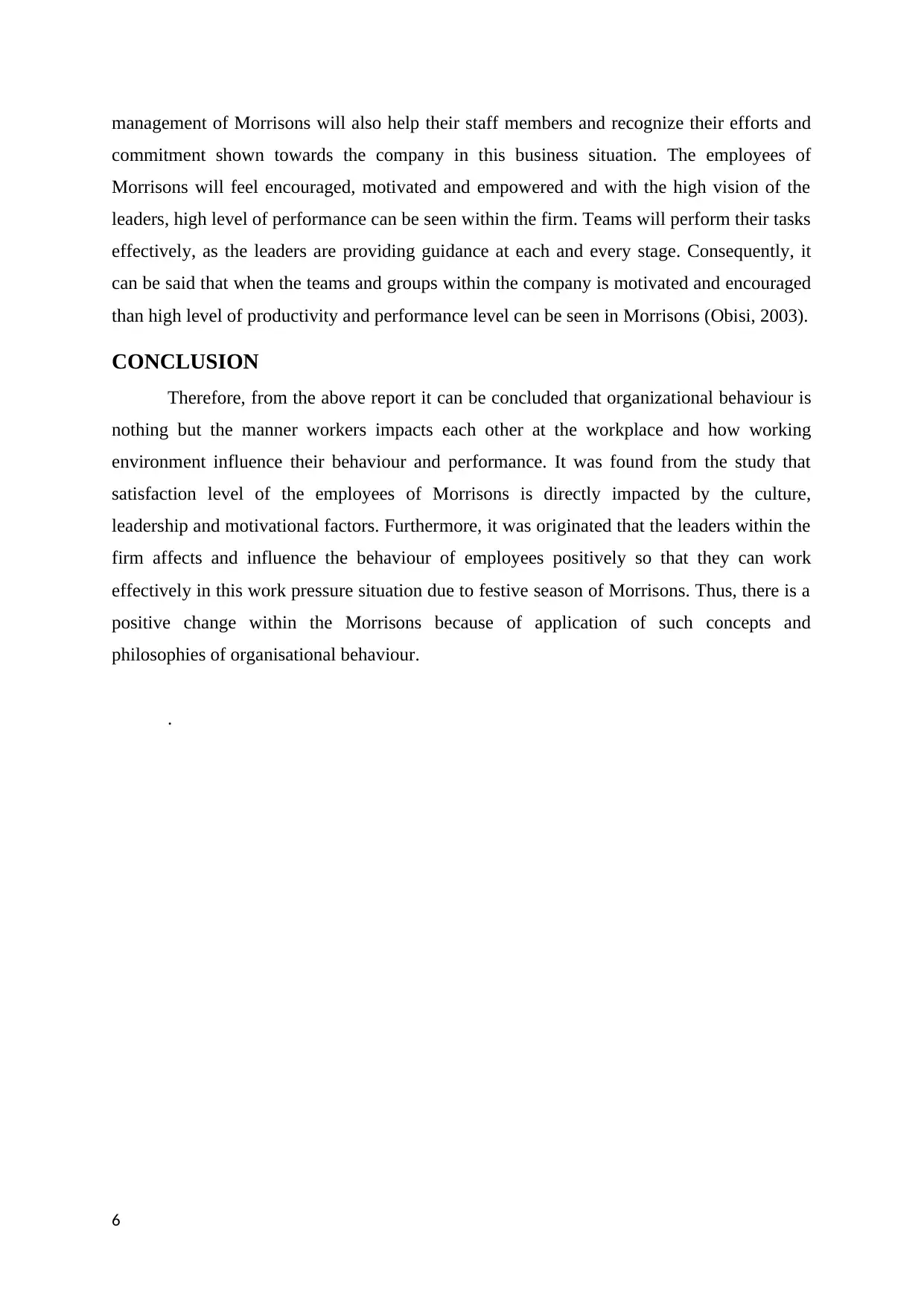
management of Morrisons will also help their staff members and recognize their efforts and
commitment shown towards the company in this business situation. The employees of
Morrisons will feel encouraged, motivated and empowered and with the high vision of the
leaders, high level of performance can be seen within the firm. Teams will perform their tasks
effectively, as the leaders are providing guidance at each and every stage. Consequently, it
can be said that when the teams and groups within the company is motivated and encouraged
than high level of productivity and performance level can be seen in Morrisons (Obisi, 2003).
CONCLUSION
Therefore, from the above report it can be concluded that organizational behaviour is
nothing but the manner workers impacts each other at the workplace and how working
environment influence their behaviour and performance. It was found from the study that
satisfaction level of the employees of Morrisons is directly impacted by the culture,
leadership and motivational factors. Furthermore, it was originated that the leaders within the
firm affects and influence the behaviour of employees positively so that they can work
effectively in this work pressure situation due to festive season of Morrisons. Thus, there is a
positive change within the Morrisons because of application of such concepts and
philosophies of organisational behaviour.
.
6
commitment shown towards the company in this business situation. The employees of
Morrisons will feel encouraged, motivated and empowered and with the high vision of the
leaders, high level of performance can be seen within the firm. Teams will perform their tasks
effectively, as the leaders are providing guidance at each and every stage. Consequently, it
can be said that when the teams and groups within the company is motivated and encouraged
than high level of productivity and performance level can be seen in Morrisons (Obisi, 2003).
CONCLUSION
Therefore, from the above report it can be concluded that organizational behaviour is
nothing but the manner workers impacts each other at the workplace and how working
environment influence their behaviour and performance. It was found from the study that
satisfaction level of the employees of Morrisons is directly impacted by the culture,
leadership and motivational factors. Furthermore, it was originated that the leaders within the
firm affects and influence the behaviour of employees positively so that they can work
effectively in this work pressure situation due to festive season of Morrisons. Thus, there is a
positive change within the Morrisons because of application of such concepts and
philosophies of organisational behaviour.
.
6
⊘ This is a preview!⊘
Do you want full access?
Subscribe today to unlock all pages.

Trusted by 1+ million students worldwide
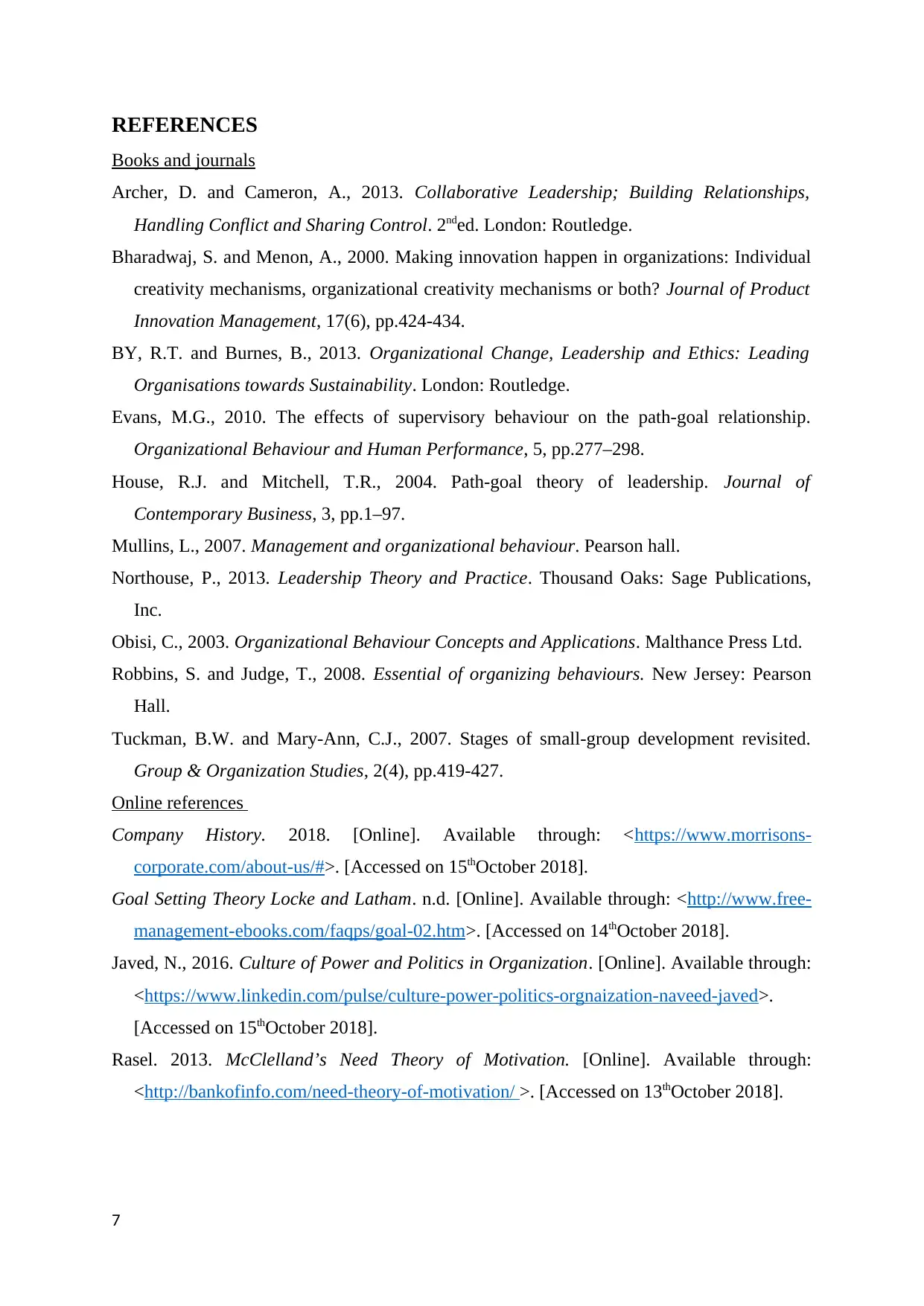
REFERENCES
Books and journals
Archer, D. and Cameron, A., 2013. Collaborative Leadership; Building Relationships,
Handling Conflict and Sharing Control. 2nded. London: Routledge.
Bharadwaj, S. and Menon, A., 2000. Making innovation happen in organizations: Individual
creativity mechanisms, organizational creativity mechanisms or both? Journal of Product
Innovation Management, 17(6), pp.424-434.
BY, R.T. and Burnes, B., 2013. Organizational Change, Leadership and Ethics: Leading
Organisations towards Sustainability. London: Routledge.
Evans, M.G., 2010. The effects of supervisory behaviour on the path-goal relationship.
Organizational Behaviour and Human Performance, 5, pp.277–298.
House, R.J. and Mitchell, T.R., 2004. Path-goal theory of leadership. Journal of
Contemporary Business, 3, pp.1–97.
Mullins, L., 2007. Management and organizational behaviour. Pearson hall.
Northouse, P., 2013. Leadership Theory and Practice. Thousand Oaks: Sage Publications,
Inc.
Obisi, C., 2003. Organizational Behaviour Concepts and Applications. Malthance Press Ltd.
Robbins, S. and Judge, T., 2008. Essential of organizing behaviours. New Jersey: Pearson
Hall.
Tuckman, B.W. and Mary-Ann, C.J., 2007. Stages of small-group development revisited.
Group & Organization Studies, 2(4), pp.419-427.
Online references
Company History. 2018. [Online]. Available through: <https://www.morrisons-
corporate.com/about-us/#>. [Accessed on 15thOctober 2018].
Goal Setting Theory Locke and Latham. n.d. [Online]. Available through: <http://www.free-
management-ebooks.com/faqps/goal-02.htm>. [Accessed on 14thOctober 2018].
Javed, N., 2016. Culture of Power and Politics in Organization. [Online]. Available through:
<https://www.linkedin.com/pulse/culture-power-politics-orgnaization-naveed-javed>.
[Accessed on 15thOctober 2018].
Rasel. 2013. McClelland’s Need Theory of Motivation. [Online]. Available through:
<http://bankofinfo.com/need-theory-of-motivation/ >. [Accessed on 13thOctober 2018].
7
Books and journals
Archer, D. and Cameron, A., 2013. Collaborative Leadership; Building Relationships,
Handling Conflict and Sharing Control. 2nded. London: Routledge.
Bharadwaj, S. and Menon, A., 2000. Making innovation happen in organizations: Individual
creativity mechanisms, organizational creativity mechanisms or both? Journal of Product
Innovation Management, 17(6), pp.424-434.
BY, R.T. and Burnes, B., 2013. Organizational Change, Leadership and Ethics: Leading
Organisations towards Sustainability. London: Routledge.
Evans, M.G., 2010. The effects of supervisory behaviour on the path-goal relationship.
Organizational Behaviour and Human Performance, 5, pp.277–298.
House, R.J. and Mitchell, T.R., 2004. Path-goal theory of leadership. Journal of
Contemporary Business, 3, pp.1–97.
Mullins, L., 2007. Management and organizational behaviour. Pearson hall.
Northouse, P., 2013. Leadership Theory and Practice. Thousand Oaks: Sage Publications,
Inc.
Obisi, C., 2003. Organizational Behaviour Concepts and Applications. Malthance Press Ltd.
Robbins, S. and Judge, T., 2008. Essential of organizing behaviours. New Jersey: Pearson
Hall.
Tuckman, B.W. and Mary-Ann, C.J., 2007. Stages of small-group development revisited.
Group & Organization Studies, 2(4), pp.419-427.
Online references
Company History. 2018. [Online]. Available through: <https://www.morrisons-
corporate.com/about-us/#>. [Accessed on 15thOctober 2018].
Goal Setting Theory Locke and Latham. n.d. [Online]. Available through: <http://www.free-
management-ebooks.com/faqps/goal-02.htm>. [Accessed on 14thOctober 2018].
Javed, N., 2016. Culture of Power and Politics in Organization. [Online]. Available through:
<https://www.linkedin.com/pulse/culture-power-politics-orgnaization-naveed-javed>.
[Accessed on 15thOctober 2018].
Rasel. 2013. McClelland’s Need Theory of Motivation. [Online]. Available through:
<http://bankofinfo.com/need-theory-of-motivation/ >. [Accessed on 13thOctober 2018].
7
1 out of 10
Related Documents
Your All-in-One AI-Powered Toolkit for Academic Success.
+13062052269
info@desklib.com
Available 24*7 on WhatsApp / Email
![[object Object]](/_next/static/media/star-bottom.7253800d.svg)
Unlock your academic potential
Copyright © 2020–2025 A2Z Services. All Rights Reserved. Developed and managed by ZUCOL.





